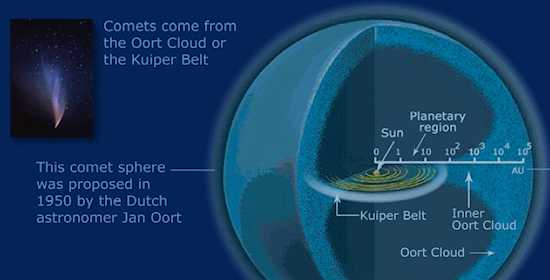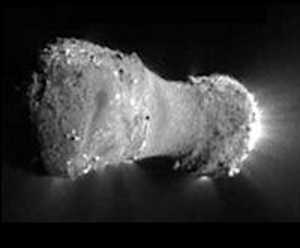
The next time you thrill at the sight of a comet blazing across the night sky, consider this: It's a stolen pleasure. You're enjoying the spectacle at the expense of a distant star.
Sophisticated computer simulations run by researchers at the Southwest Research Institute (SWRI) have exposed the crime.
“If the results are right, our Sun snatched comets from neighboring stars' back yards,” said SWRI scientist Hal Levison. And he believes this kind of thievery accounts for most of the comets in the Oort Cloud at the edge of our solar system.
“We know that stars form in clusters,” Levison said. “The Sun was born within a huge community of other stars that formed in the same gas cloud. In that birth cluster, the stars were close enough together to pull comets away from each other via gravity. It's like neighborhood children playing in each others' back yards. It's hard to imagine it not happening.”
According to this “thief” model, comets accompanied the nearest star when the birth cluster blew apart.
The Sun made off with quite a treasure – the Oort Cloud, which was swarming with comets from all over the “neighborhood.”
The Oort cloud is an immense cloud of comets orbiting the Sun far beyond Pluto. It is named after mid-20th century Dutch astronomer Jan Oort, who first proposed such a cloud to explain the origin of comets sometimes seen falling into the inner solar system.
Although no confirmed direct observations of the Oort cloud have been made, most astronomers believe that it is the source of all long-period and Halley-type comets.
The standard model of comet production asserts that our Sun came by these comets honestly.

“That model says the comets are dregs of our own solar system's planetary formation and that our planets gravitationally booted them to huge distances, populating the cloud,” said Levison. “But we believe this kind of scenario happened in all the solar systems before the birth cluster dispersed.”
Otherwise, said Levison, the numbers just don't add up.
“The standard model can't produce anywhere near the number of comets we see [falling in from the Oort Cloud]. The Sun's sibling stars had to have contributed some comets to the mix,” Levison said.
Comets in the Oort Cloud are typically one or two miles across, and they're so far away that estimating their numbers is no easy task. But Levison and his team said that, based on observations, that there should be something like 400 billion comets there. The “domestic” model of comet formation can account for a population of only about 6 billion.
“That's a pretty anemic Oort Cloud, and a huge discrepancy – too huge to be explained by mistakes in the estimates. There's no way we could be that far off, so there has to be something wrong with the model itself,” Levison said.
He pointed to the cometary orbits as evidence.
“These comets are in very odd orbits – highly eccentric long-period orbits that take them far from our Sun, into remote regions of space,” he said. “So they couldn't have been born in orbit around the Sun. They had to have formed close to other stars and then been hijacked here.”
This means comets can tell us not only about the early history of the Sun – but also about the history of other stars.
“We can study the orbits of comets and put their chemistry into the context of where and around which star they formed,” Levison said. “It's intriguing to think we got some of our 'stuff' from distant stars. We're kin.”
Dauna Coulter works for the National Aeronautics and Space Administration.
Follow Lake County News on Twitter at http://twitter.com/LakeCoNews , on Facebook at http://www.facebook.com/pages/Lake-County-News/143156775604?ref=mf and on YouTube at http://www.youtube.com/user/LakeCoNews .


 How to resolve AdBlock issue?
How to resolve AdBlock issue? 





